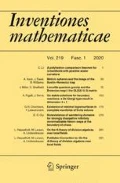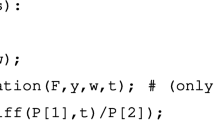Abstract
In this paper we study self-adjoint commuting ordinary differential operators of rank two. We find sufficient conditions when an operator of fourth order commuting with an operator of order 4g+2 is self-adjoint. We introduce an equation on potentials V(x),W(x) of the self-adjoint operator \(L=(\partial_{x}^{2}+V)^{2}+W\) and some additional data. With the help of this equation we find the first example of commuting differential operators of rank two corresponding to a spectral curve of higher genus. These operators have polynomial coefficients and define commutative subalgebras of the first Weyl algebra.
Similar content being viewed by others
References
Wallenberg, G.: Über die Vertauschbarkeit homogener linearer Differentialausdrücke. Arch. Math. Phys. 4, 252–268 (1903)
Schur, J.: Über vertauschbare lineare Differentialausdrücke. Sitzungsber. Berl. Math. Ges. 4, 2–8 (1905)
Burchnall, J.L., Chaundy, I.W.: Commutative ordinary differential operators. Proc. Lond. Math. Soc. Ser. 2. 21, 420–440 (1923)
Krichever, I.M.: Integration of nonlinear equations by the methods of algebraic geometry. Funct. Anal. Appl. 11(1), 12–26 (1977)
Krichever, I.M.: Commutative rings of ordinary linear differential operators. Funct. Anal. Appl. 12(3), 175–185 (1978)
Drinfeld, V.G.: Commutative subrings of certain noncommutative rings. Funct. Anal. Appl. 11(3), 9–12 (1977)
Mumford, D.: An algebro-geometric construction of commuting operators and of solutions to the Toda lattice equation, Korteweg-de Vries equation and related non-linear equations. In: Nagata, M. (ed.) Proceedings Int. Symp. Algebraic Geometry, Kyoto, 1977, pp. 115–153. Kinokuniya Book Store, Tokyo (1978)
Krichever, I.M., Novikov, S.P.: Holomorphic bundles over Riemann surfaces and the Kadomtsev-Petviashvili equation. I. Funct. Anal. Appl. 12(4), 276–286 (1978)
Krichever, I.M., Novikov, S.P.: Holomorphic bundles over algebraic curves and nonlinear equations. Russ. Math. Surv. 35(6), 47–68 (1980)
Grinevich, P.G., Novikov, S.P.: Spectral theory of commuting operators of rank two with periodic coefficients. Funct. Anal. Appl. 16(1), 19–20 (1982)
Grinevich, P.G.: Rational solutions for the equation of commutation of differential operators. Funct. Anal. Appl. 16(1), 15–19 (1982)
Grunbaum, F.: Commuting pairs of linear ordinary differential operators of orders four and six. Physica D 31(3), 424–433 (1988)
Latham, G.: Rank 2 commuting ordinary differential operators and Darboux conjugates of KdV. Appl. Math. Lett. 8(6), 73–78 (1995)
Latham, G., Previato, E.: Darboux transformations for higher-rank Kadomtsev-Petviashvili and Krichever-Novikov equations. Acta Appl. Math. 39, 405–433 (1995)
Mokhov, O.I.: On commutative subalgebras of Weyl algebra, which are associated with an elliptic curve. In: International Conference on Algebra in Memory of A.I. Shirshov (1921–1981), Barnaul, USSR, 20–25 August, p. 85 (1991). Reports on theory of rings, algebras and modules
Mokhov, O.I.: On the commutative subalgebras of Weyl algebra, which are generated by the Chebyshev polynomials. In: Third International Conference on Algebra in Memory of M.I. Kargapolov (1928–1976), Krasnoyarsk, Russia, 23–28 August 1993, p. 421. Inoprof, Krasnoyarsk (1993)
Previato, E., Wilson, G.: Differential operators and rank 2 bundles over elliptic curves. Compos. Math. 81(1), 107–119 (1992)
Dehornoy, P.: Opérateurs différentiels et courbes elliptiques. Compos. Math. 43(1), 71–99 (1981)
Mokhov, O.I.: Commuting differential operators of rank 3 and nonlinear differential equations. Math. USSR, Izv. 35(3), 629–655 (1990)
Mironov, A.E.: A ring of commuting differential operators of rank 2 corresponding to a curve of genus 2. Sb. Math. 195(5), 711–722 (2004)
Mironov, A.E.: On commuting differential operators of rank 2. Sib. Electron. Math. Rep. 6, 533–536 (2009)
Mironov, A.E.: Commuting rank 2 differential operators corresponding to a curve of genus 2. Funct. Anal. Appl. 39(3), 240–243 (2005)
Zuo, D.: Commuting differential operators of rank 3 associated to a curve of genus 2. SIGMA 8, 044 (2012)
Dubrovin, B.A., Matveev, V.B., Novikov, S.P.: Non-linear equations of Korteweg–de Vries type, finite-zone linear operators, and Abelian varieties. Usp. Mat. Nauk 31:1(187), 55–136 (1976)
Dixmier, J.: Sur les algèbres de Weyl. Bull. Soc. Math. Fr. 96, 209–242 (1968)
Acknowledgements
The author is grateful to I.M. Krichever, O.I. Mokhov, S.P. Novikov and V.V. Sokolov for valuable discussions and stimulating interest.
Author information
Authors and Affiliations
Corresponding author
Additional information
This paper was completed in the Hausdorff Research Institute for Mathematics (Bonn). The author is grateful to the Institute for hospitality. This work was also partially supported by grant 12-01-33058 from the Russian Foundation for Basic Research; grant MD-5134.2012.1 from the President of Russia; and a grant from Dmitri Zimin’s “Dynasty” foundation.
Appendix
Appendix
In this Appendix we study (23).
Lemma 5
There exists a Zariski open set U⊂C 4 such that for every (α 0,…,α 3)∈U polynomial F g (z) has no multiple roots of order greater than two.
Proof
To prove the lemma we represent F g in the form
and prove that \(F_{g}^{0}(z)\) has g double roots and one simple root.
Let us consider (20)–(22). We put \(\delta_{g}=\alpha_{3}^{g}\), then
Moreover, from (20) it follows that Q has the form
for some p i =p i (z),q i =q i (z). Let us note that from (22) it follows that
Let us substitute (24) into (15). We get
so,
Let us find p i . For this we again substitute (24) into (19) and find the coefficients at \(\alpha_{3}^{i+1}x^{i}\). These coefficients must be equal to zero. This gives us
Hence
where A i is a constant. Lemma 5 is proved. □
Rights and permissions
About this article
Cite this article
Mironov, A.E. Self-adjoint commuting ordinary differential operators. Invent. math. 197, 417–431 (2014). https://doi.org/10.1007/s00222-013-0486-8
Received:
Accepted:
Published:
Issue Date:
DOI: https://doi.org/10.1007/s00222-013-0486-8



